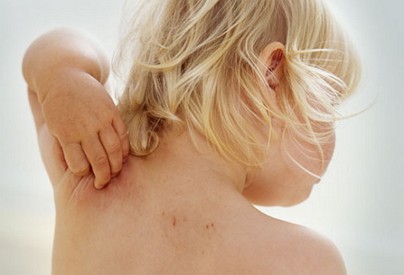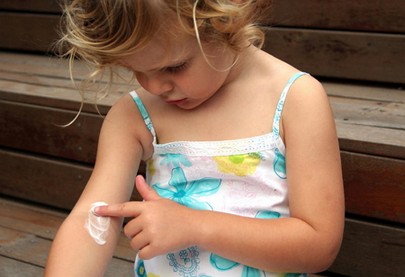Dry Skin in Children

Contents:
- Dry Skin in Children
- Why Does a Child Have Dry Skin?
- Dry Feet in a Child
- Dry Skin Treatment in Children
- Dry Skin of the Child as a Sign of a Disease
- Dry Spots on the Baby's Skin
Dry Skin in Children
The skin is one of the most important organs of the human body. It serves several functions: barrier, excretory, sensitive, thermoregulatory, storage and others. Therefore, parents must from early childhood, closely monitor the condition of skin covering of their babies.
Normally, baby's skin should be clean, smooth, without cracks and inflammations. In the case of any visible abnormalities (redness or roughness), parents should pay attention to it. Children's body signals that it failed. If a child has dry skin, it means that its stratum corneum contains inadequate amount moisture.
Its appearance changes – it becomes rough, wrinkled, sometimes even scaly loses its elasticity. But it's not the worst. Dry skin has cracks through which bacteria penetrate the deeper layers and cause the development of dermatologic diseases.
Why Does a Child Have Dry Skin?
Dry skin in child occurs usually during the first three years of life in the autumn-winter period or early spring. This phenomenon can be observed on individual parts of the body (hands, feet, face), as well as on its entire surface. Children's skin is very sensitive to external factors, its protective function is only developing. So, in the case of dry specks or rashes on the body it is important to identify what items of personal hygiene can cause irritation of the epidermis, and stop using shampoos, soaps, washing powders, gels that baby may be allergic to.
If a child has dry skin, choose only hypoallergenic personal hygiene and washing products, preferably without strong smell and bright colors. You should not bathe your baby in hot water, it tends to dry the skin, the temperature of 37 °C is ideal for bathing.
Sudden changes in temperature can also be a cause of dry skin in the child. Severe frost and cold winds often cause irritation and redness on the face and hands. So before going out, don’t forget to lubricate the kid’s exposed areas of the body with a special cream. Winter heating systems dry the air in apartments, so during this period, it is recommended to use special air moisturizers. Dry skin in a child may be an allergic reaction, so you should pay attention to the diet. Some products provoke allergies, particularly citrus fruits and chocolates.
Dry Feet in a Child
Quite often children have dry skin on their legs. Especially in summer it loses moisture and begins to crack and ache. In this case, it is better to wear open shoes with maximum access of air. To avoid falling dust and dirt into the cracks, it is important to wear socks. Be sure to wash the child’s feet with kid’s soap before the bedtime, wipe them dry and lubricate them, massaging the special softening cream with vitamins.
Dry feet skin in children has a high susceptibility to infections, which may cause complications. Everyone is familiar with sweating fever, diaper dermatitis, and darter which spread quickly when the care is insufficient. To avoid complications, you should as quickly as possible show your child the doctor and start treatment.
Dry Skin Treatment in Children

The epidermis of small children is not yet able to retain water in sufficient quantities, therefore it is necessary to fill it from the outside. To the choice of the moisturizing product must be serious, because the skin responds to external stimuli. If a child has very dry skin, ask your pediatrician to choose the product. In such cases, doctors often recommend products for external application with urea content, in particular, Excipial M, plus additional vitamin A intake for a period of two months. It is better digested if you drop it on a small piece of black bread before eating.
In some cases, if the skin is inflamed, the doctor prescribe vitamin E, calcium, and fish oil. The dose of medication is prescribed by a doctor. It is better not to use any foaming products when bathing the child. Herbal baths are very effective in such cases. You need to mix in equal proportions rose petals and chamomile flowers, pour boiling water over and brew for 15-20 minutes. Then drain and add water. The procedure should last at least 10 minutes. Bath with flax oil is also very effective (1 tablespoon will suffice). After bathing you can massage baby’s skin, treating it with cream that contains vitamin a.
Dry Skin of the Child as a Sign of a Disease
Sometimes dry skin may indicate the beginning of a disease. Therefore, if you notice redness or irritation, consult a doctor to make an accurate diagnosis, determine the cause and begin treatment.
Dry skin in the child of up to 1 year old is often indicative of atopic dermatitis. Severely itchy, reddened patches are located on the face, without affecting the nasolabial triangle. Flaky, scaly skin on elbows, knees, and cheeks may be symptoms of ichthyosis – a genetic disorder in which the process of keratinization of cells is disrupted.
If the child's skin is very dry and flaky, this is most likely a deficiency of vitamins A and PP, treatment in the form of intake of these essential vitamins eliminates unpleasant symptoms. Be aware that dry skin can be caused by dehydration in dyspeptic disorders (vomiting, diarrhea) and strong perspiration.
Dry Spots on the Baby's Skin
Dry spots on child’s body may appear often, and there is nothing unusual or wrong because it is very sensitive. But parents should be worried if they don't go away for a long time. Firstly, the reason of these spots may be physiological, because babies do not yet have fully functioning dispose glands. Secondly, environmental factors affect the condition of the skin (temperature and hardness of water, humidity of the air, food, soap). Initially, you could use pharmacy products to soften the impacted areas (for example, Panthenol).
But if the dry spots on the baby's skin do not disappear, you should consult your doctor, as these can be symptoms of serious diseases such as atopic dermatitis, eczema, psoriasis. It is usually difficult to treat skin ailments, but the right diagnosis will ease this problem. If there are early age signs of a skin disease already at an early age, it is very important to take immediate measures and prevent its progression. Otherwise, without proper treatment, it could grow into a chronic form.